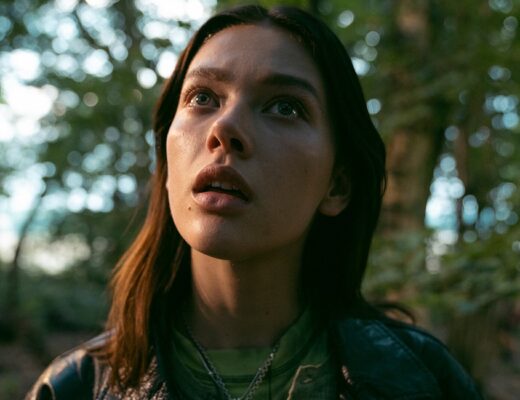Sin Eater is a remarkably rough first draft masquerading as a finished film.
There’s a recent episode of the PVD Horror Podcast that features the cast and crew of the new micro-budget horror movie Sin Eater. There’s writer/director Carmelo Chimera, male leads Danny & Scotty Bohnen, and the star of the movie, Jessie Nerud. It’s an absolute pleasure listening to these fledgling filmmakers discuss the ins and outs of indie filmmaking; the Bohnens detail their long friendship with Nerud, how they first met Chimera, and the casting of their stepdad in an important supporting role. There’s anecdotes about location shooting, set decorating, the perils of working with child actors, and even the intricacies of a fairly large-scale car stunt. Everyone lights up as they discuss genre legend Bill Moseley, who appears in a small cameo role, and is apparently an absolute dream to work with. Indeed, everyone involved seems incredibly passionate about the project, pulling together to realize their vision with such meager financial means. A quick perusal of the film’s credits reveal people pulling double- and triple-duties, roping in their wives and other family members to help out. It’s genuinely inspirational and a must-listen for any aspiring filmmakers out there.
Unfortunately, the film itself is more a cautionary tale about the limits of enthusiasm when it comes crashing into the brick wall of cold, hard reality. Sin Eater is patently awful, the kind of thing that might sell out a single screening at a small, regional film fest with cast and crew and family in attendance, all excited to see themselves and their loved ones up on a big screen before retiring to someone’s house for a delightful afterparty. This is a student short (at best) expanded to feature-length, one that should never have seen the light of day. It’s basically the opposite of a calling card film. Most viewers with even a vague awareness of film production know that movies are shot non-sequentially, making use of actors and locations when they are available to maximize shooting schedules. Sin Eater frequently gives the impression that the filmmakers were literally learning as they went, scene by scene, except instead of shooting rehearsals or test footage, it all just wound up jumbled together in the final film. The acting, blocking, cinematography, and special effects all vary wildly throughout the film, relatively coherent in one moment but suddenly disorienting and amateurish in the next.
The screenplay itself isn’t bad, exactly; it certainly doesn’t lack for ambition. It begins with Isaac (Danny Bohnen), sheriff of some nondescript small town, stumbling upon the aftermath of a car crash. One woman lays dead, while the other is badly wounded. A quick cut takes us to the interior of a well-appointed but old fashioned home; Christine (Nerud) awakens to find her face badly swollen and her mouth wired shut. A nurse, Elijah (Scotty Bohnen), stops by to check on his patient, bickering with Isaac as he enters the home. It becomes clear that there’s bad blood between the men, and that both have designs on the injured young woman. As she recuperates, Christine meets more locals, including pastor Abraham (Scott Moore). She also has nightmarish dreams that eventually reveal themselves to be flashbacks, with a violent priest (Moseley, in his brief cameo role) performing some kind of exorcism. Eventually, Christine realizes that the local religion is more like a cult, and that she is a prisoner set to be sacrificed to appease their particular god.
This is all well and good, a perfectly reasonable foundation to build a horror movie onto. Any genre fan can tell you that plenty of movies have started off with less. But Sin Eater never rises above dreadful, the act of watching the film bordering on painful. The acting is awkward and stilted, and done absolutely no favors by the disinterested camerawork. Virtually every composition is off-center or lopsided, with dead space all around the edges. Characters are placed willy-nilly in the frame, with no real consideration for how the body interacts with space. Sometimes the camera just sits there while characters recite their dialogue, and even the familiar shot/counter-shot technique, the most rudimentary way to film back-and forth-dialogue scenes, is hampered by poor editing. There are several nighttime sequences that actually accomplish a certain moody atmosphere, and these are the most successful bits in the film. But even here, there’s no real consistency. Some scenes are lit by a single light source, creating a kind of cheap-o chiaroscuro, while others are just generic blue gels slathered over the image. It’s all a mess, an 85-minute rough draft that should have been considered a basic starting point, not a finished film to unleash upon an unsuspecting audience. Just listen to the podcast episode instead; it’s shorter and far more edifying.
Published as part of Before We Vanish — March 2022.







